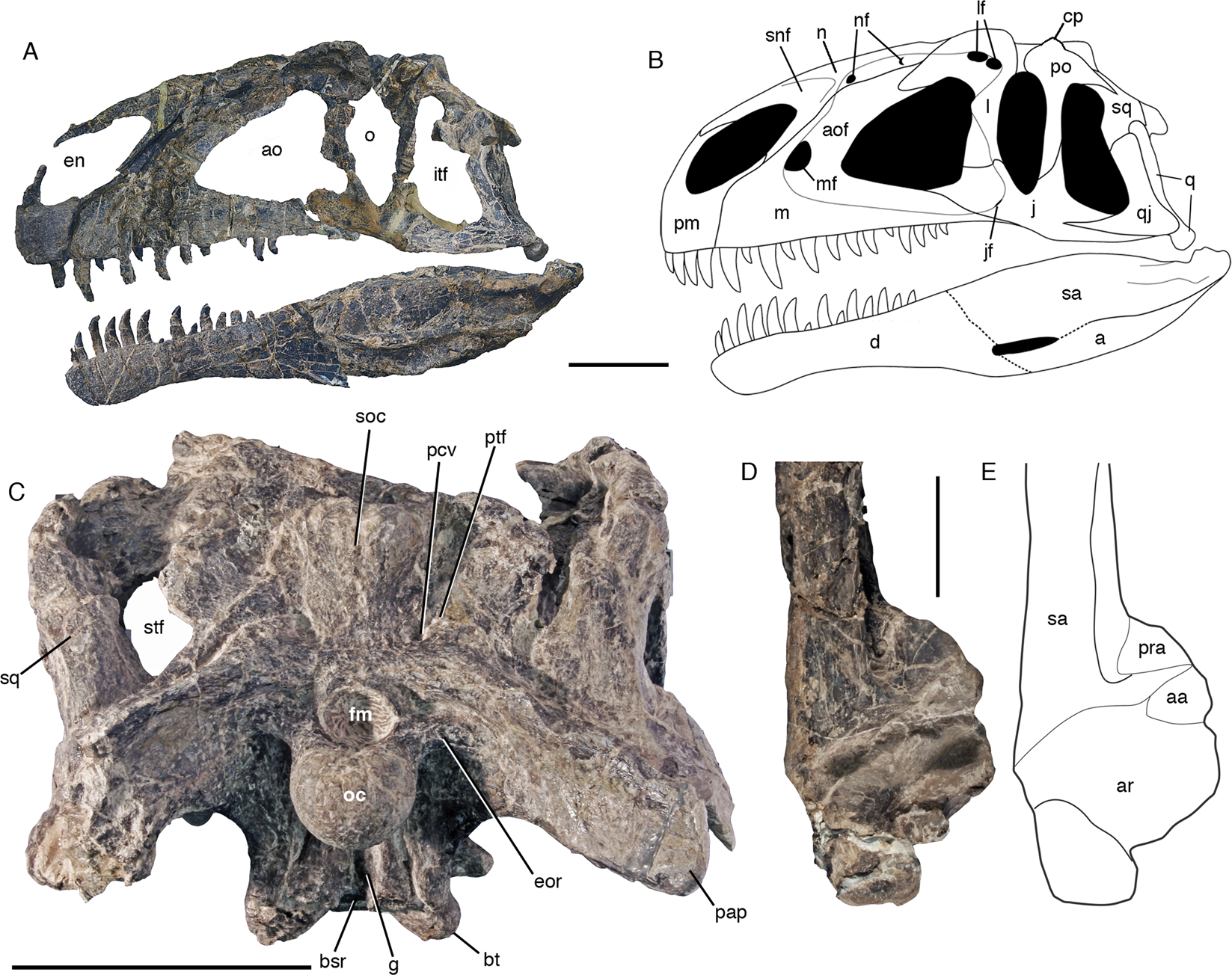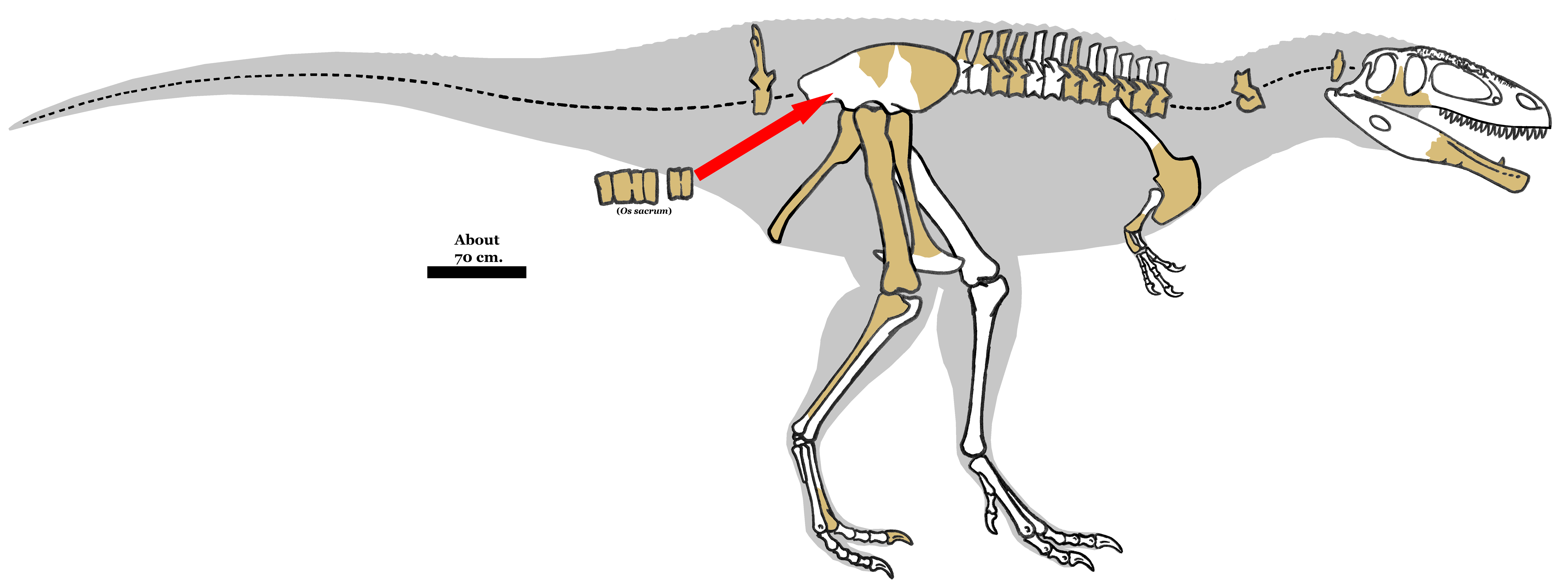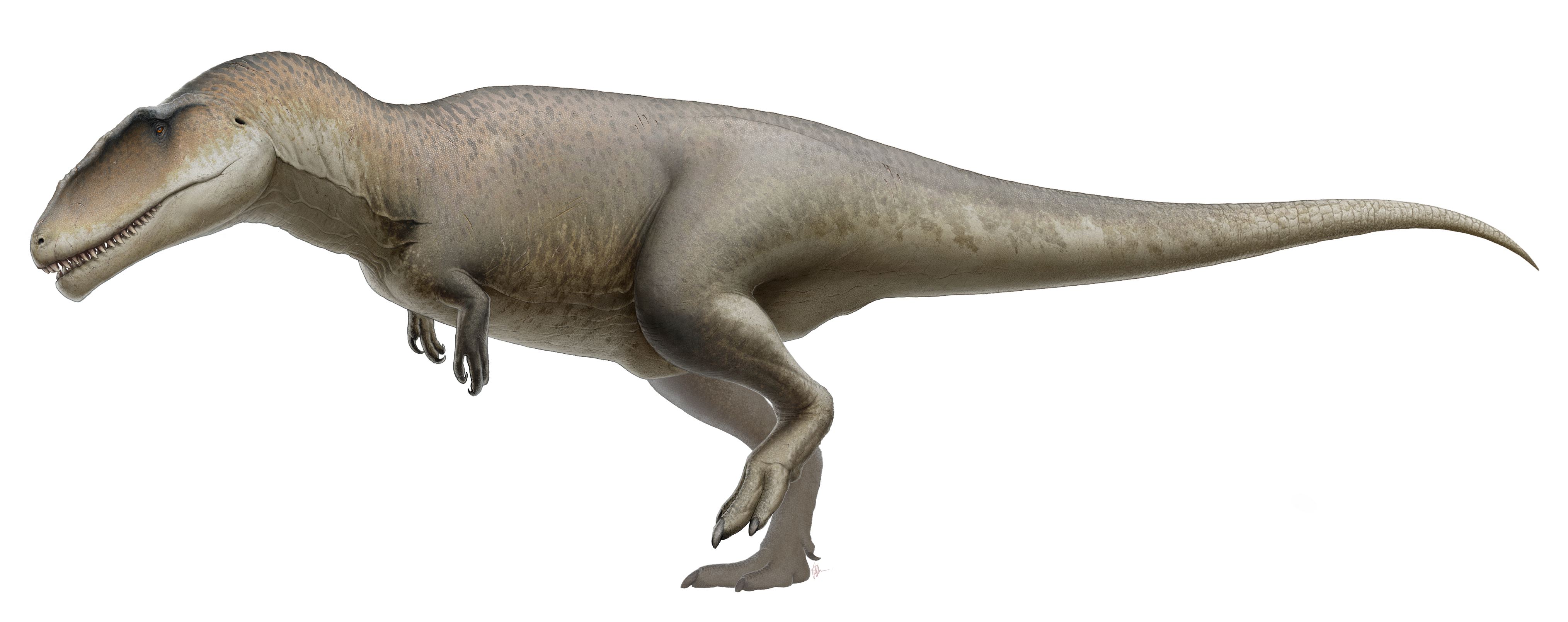|
Carnosauria
Carnosauria is an extinct large group of predatory dinosaurs that lived during the Jurassic and Cretaceous periods. Starting from the 1990s, scientists have discovered some very large carnosaurs in the carcharodontosaurid family, such as ''Giganotosaurus'', ''Mapusaurus'', ''Carcharodontosaurus'' and ''Tyrannotitan'' which are among the largest known predatory dinosaurs. While it originally contained a wide assortment of giant theropods that were not closely related, the group has since been defined to encompass only the allosaurs and their closest kin. However, with the description and publication in 2019 of ''Asfaltovenator vialidadi'', a basal allosauroid curiously displaying both primitive and derived features seen in Tetanurae, the new phylogenetic analysis has found Megalosauroidea to be a basal grade of carnosaurs in respect to Allosauroidea; thus significantly expanding Carnosauria's inclusiveness towards its original context. Distinctive characteristics of carnosaurs ... [...More Info...] [...Related Items...] OR: [Wikipedia] [Google] [Baidu] |
Mapusaurus
''Mapusaurus'' () was a giant carcharodontosaurid carnosaurian dinosaur from the early Late Cretaceous (early Turonian stage), approximately 93.9 to 89.6 million years ago, of what is now Argentina. Discovery ''Mapusaurus'' was excavated between 1997 and 2001, by the Argentinian-Canadian Dinosaur Project, from an exposure of the Huincul Formation ( Rio Limay Subgroup, Cenomanian) at Cañadón del Gato. It was described and named by paleontologists Rodolfo Coria and Phil Currie in 2006. The name ''Mapusaurus'' is derived from the Mapuche word ''Mapu'', meaning 'of the Land' or 'of the Earth' and the Greek ''sauros'', meaning 'lizard'. The type species, ''Mapusaurus roseae'', is named for both the rose-colored rocks, in which the fossils were found and for Rose Letwin, who sponsored the expeditions which recovered these fossils. The designated holotype for the genus and type species, ''Mapusaurus roseae'', is an isolated right nasal (MCF-PVPH-108.1, Museo Carmen Funes, Paleo ... [...More Info...] [...Related Items...] OR: [Wikipedia] [Google] [Baidu] |
Unquillosaurus
''Unquillosaurus'' (meaning "Unquillo river lizard") is a genus of possible maniraptoran or carnosaurian theropod dinosaur from the Late Cretaceous Los Blanquitos Formation of Salta Province, Argentina. The genus contains a single species, ''U. ceibalii'', known only from a single fossilized pubis (a pelvic bone).HyperWorks Reference Software (1999),The Dinosaur Encyclopedia: ''Unquillosaurus'', viewed December 07, 2012. Discovery and naming The holotype, PVL 3670-11, was found at Arroyo-Morterito in the Los Blanquitos Formation, dating to the Campanian. It consists of a left pubis, long. The specimen was re-studied by Fernando Novas and Federico Agnolin in 2004, who concluded that the orientation of the pubis had been misinterpreted: it pointed backwards, as was shown by the fossil still being attached to a displaced part of the pubic peduncle of the ilium.Novas and Agnolin, (2004). "''Unquillosaurus ceibalii'' Powell, a giant maniraptoran (Dinosauria, Theropoda) from the ... [...More Info...] [...Related Items...] OR: [Wikipedia] [Google] [Baidu] |
Middle Jurassic
The Middle Jurassic is the second epoch of the Jurassic Period. It lasted from about 174.1 to 163.5 million years ago. Fossils of land-dwelling animals, such as dinosaurs, from the Middle Jurassic are relatively rare, but geological formations containing land animal fossils include the Forest Marble Formation in England, the Kilmaluag Formation in Scotland,British Geological Survey. 2011Stratigraphic framework for the Middle Jurassic strata of Great Britain and the adjoining continental shelf: research report RR/11/06 British Geological Survey, Keyworth, Nottingham. the Daohugou Beds in China, the Itat Formation in Russia, and the Isalo III Formation of western Madagascar. Paleogeography During the Middle Jurassic Epoch, Pangaea began to separate into Laurasia and Gondwana, and the Atlantic Ocean formed. Eastern Laurasia was tectonically active as the Cimmerian plate continued to collide with Laurasia's southern coast, completely closing the Paleo-Tethys Ocean. A subduction zone ... [...More Info...] [...Related Items...] OR: [Wikipedia] [Google] [Baidu] |
Spinosauridae
The Spinosauridae (or spinosaurids) are a clade or family of tetanuran theropod dinosaurs comprising ten to seventeen known genera. They came into prominence during the Cretaceous period. Spinosaurid fossils have been recovered worldwide, including Africa, Europe, South America and Asia. Their remains have generally been attributed to the Early to Mid Cretaceous. Spinosaurids were large bipedal carnivores. Their crocodilian-like skulls were long, low and narrow, bearing conical teeth with reduced or absent serrations. The tips of their upper and lower jaws fanned out into a spoon-shaped structure similar to a rosette, behind which there was a notch in the upper jaw that the expanded tip of the lower jaw fit into. The nostrils of spinosaurids were retracted to a position further back on the head than in most other theropods, and they had bony crests on their heads along the midline of their skulls. Their robust shoulders wielded stocky forelimbs, with three-fingered hands that b ... [...More Info...] [...Related Items...] OR: [Wikipedia] [Google] [Baidu] |
Evolutionary Grade
A grade is a taxon united by a level of morphological or physiological complexity. The term was coined by British biologist Julian Huxley, to contrast with clade, a strictly phylogenetic unit. Definition An evolutionary grade is a group of species united by morphological or physiological traits, that has given rise to another group that has major differences from the ancestral condition, and is thus not considered part of the ancestral group, while still having enough similarities that we can group them under the same clade. The ancestral group will not be phylogenetically complete (i.e. will not form a clade), so will represent a paraphyletic taxon. In order to fully understand evolutionary grades, one must first get a better understanding of Phylogenetics, defined as "''In biology, is the study of the evolutionary history and relationships among individuals or groups of organisms (e.g. species, or populations). These relationships are discovered through phylogenetic i ... [...More Info...] [...Related Items...] OR: [Wikipedia] [Google] [Baidu] |
Tetanurae
Tetanurae (/ˌtɛtəˈnjuːriː/ or "stiff tails") is a clade that includes most theropod dinosaurs, including megalosauroids, allosauroids, tyrannosauroids, ornithomimosaurs, compsognathids and maniraptorans (including birds). Tetanurans are defined as all theropods more closely related to modern birds than to ''Ceratosaurus'' and contain the majority of predatory dinosaur diversity. Tetanurae likely diverged from its sister group, Ceratosauria, during the late Triassic. Tetanurae first appeared in the fossil record by the Early Jurassic about 190 mya and by the Middle Jurassic had become globally distributed. The group was named by Jacques Gauthier in 1986 and originally had two main subgroups: Carnosauria and Coelurosauria, the clade containing birds and related dinosaurs such as compsognathids, tyrannosaurids, ornithomimosaurs, and maniraptorans. The original Carnosauria was a polyphyletic group including any large carnivorous theropod. Many of Gauthier's carnosaurs, such ... [...More Info...] [...Related Items...] OR: [Wikipedia] [Google] [Baidu] |
Asfaltovenator
''Asfaltovenator'' (meaning "Cañadón Asfalto Formation hunter" after the fossil formation in which its fossils were found) is a genus of possibly allosauroid dinosaur from the Lower Jurassic Cañadón Asfalto Formation from Chubut Province, Argentina. The type and only species is ''Asfaltovenator vialidadi''. Discovery In 2002, technician Leandro Canesa, roughly a mile north of Cerro Condor, discovered a theropod skeleton. Excavations started in 2005. In 2007, the fossil was in its entirety removed as an enormous stone block, covered by plaster of Paris. It was then prepared by Mariano Caffa, a process that took five years due to the extreme hardness of the stone matrix. Between 2013 and 2015, it was compared with the specimens of related theropods, researchers personally investigating their exemplars in collections all over the world. In 2019, the type species ''Asfaltovenator vialidadi'' was named and described by Oliver Walter Mischa Rauhut and Diego Pol. The generic name ... [...More Info...] [...Related Items...] OR: [Wikipedia] [Google] [Baidu] |
Theropod
Theropoda (; ), whose members are known as theropods, is a dinosaur clade that is characterized by hollow bones and three toes and claws on each limb. Theropods are generally classed as a group of saurischian dinosaurs. They were ancestrally carnivorous, although a number of theropod groups evolved to become herbivores and omnivores. Theropods first appeared during the Carnian age of the late Triassic period 231.4 million years ago ( Ma) and included all the large terrestrial carnivores from the Early Jurassic until at least the close of the Cretaceous, about 66 Ma. In the Jurassic, birds evolved from small specialized coelurosaurian theropods, and are today represented by about 10,500 living species. Biology Diet and teeth Theropods exhibit a wide range of diets, from insectivores to herbivores and carnivores. Strict carnivory has always been considered the ancestral diet for theropods as a group, and a wider variety of diets was historically considered a characteri ... [...More Info...] [...Related Items...] OR: [Wikipedia] [Google] [Baidu] |
Tyrannotitan
''Tyrannotitan'' (; ) is a genus of huge bipedal carnivorous dinosaur of the carcharodontosaurid family from the Aptian stage of the early Cretaceous period, discovered in Argentina. It is closely related to other giant predators like ''Carcharodontosaurus'' and especially ''Giganotosaurus'' as well as ''Mapusaurus''. Discovery and species ''Tyrannotitan chubutensis'' was described by Fernando E. Novas, Silvina de Valais, Pat Vickers-Rich, and Tom Rich in 2005. The fossils were found at La Juanita Farm, northeast of Paso de Indios, Chubut Province, Argentina. They are believed to have been from the Cerro Castaño Member, Cerro Barcino Formation (Aptian stage). The holotype material was designated MPEF-PV 1156 and included partial dentaries, teeth, back vertebrae 3–8 and 11–14, proximal tail vertebrae, ribs and chevrons, a fragmentary scapulocoracoid, humerus, ulna, partial ilium, a nearly complete femur, fibula, and left metatarsal 2. Additional material (designated M ... [...More Info...] [...Related Items...] OR: [Wikipedia] [Google] [Baidu] |
Carcharodontosaurus
''Carcharodontosaurus'' (; ) is a genus of large carcharodontosaurid theropod dinosaur that existed during the Cenomanian age of the Late Cretaceous in Northern Africa. The genus ''Carcharodontosaurus'' is named after the shark genus ''Carcharodon'', itself composed of the Greek (, meaning "jagged" or "sharp") and (, "teeth"), and the suffix ' ("lizard"). It is currently known to have two species: ''C. saharicus'' and ''C. iguidensis''. History of discovery In 1924, two teeth were found in the Continental intercalaire of Algeria, showing what were at the time unique characteristics. These teeth were described by Depéret and Savornin (1925) as representing a new taxon, which they named ''Megalosaurus saharicus'' and later categorized in the subgenus ''Dryptosaurus''. Some years later, paleontologist Ernst Stromer described the remains of a partial skull and skeleton from Cenomanian aged rocks in the Bahariya Formation of Egypt (Stromer, 1931); originally excavated in 1914, ... [...More Info...] [...Related Items...] OR: [Wikipedia] [Google] [Baidu] |
Giganotosaurus
''Giganotosaurus'' ( ) is a genus of theropod dinosaur that lived in what is now Argentina, during the early Cenomanian age of the Late Cretaceous period, approximately 99.6 to 95 million years ago. The holotype specimen was discovered in the Candeleros Formation of Patagonia in 1993 and is almost 70% complete. The animal was named ''Giganotosaurus carolinii'' in 1995; the genus name translates to "giant southern lizard", and the specific name honors the discoverer, Rubén D. Carolini. A dentary bone, a tooth, and some tracks, discovered before the holotype, were later assigned to this animal. The genus attracted much interest and became part of a scientific debate about the maximum sizes of theropod dinosaurs. ''Giganotosaurus'' was one of the largest known terrestrial carnivores, but the exact size has been hard to determine due to the incompleteness of the remains found so far. Estimates for the most complete specimen range from a length of , a skull in length, and a we ... [...More Info...] [...Related Items...] OR: [Wikipedia] [Google] [Baidu] |
Carcharodontosauridae
Carcharodontosauridae (carcharodontosaurids; from the Greek καρχαροδοντόσαυρος, ''carcharodontósauros'': "shark-toothed lizards") is a group of carnivorous theropod dinosaurs. In 1931, Ernst Stromer named Carcharodontosauridae as a family, which, in modern paleontology, indicates a clade within Carnosauria. Carcharodontosaurids include some of the largest land predators ever known: ''Giganotosaurus'', ''Mapusaurus'', ''Carcharodontosaurus'', and ''Tyrannotitan'' all rivaled or exceeded ''Tyrannosaurus'' in size. A 2015 paper by Christophe Hendrickx and colleagues gives a maximum length estimate of for the largest carcharodontosaurids, while the smallest carcharodontosaurids were estimated to have been at least long. Evolution Along with the spinosaurids, carcharodontosaurids were the largest predators in the early and middle Cretaceous throughout Gondwana, with species also present in North America (''Acrocanthosaurus''), Europe (''Concavenator'') and Asia ... [...More Info...] [...Related Items...] OR: [Wikipedia] [Google] [Baidu] |
.jpg)






